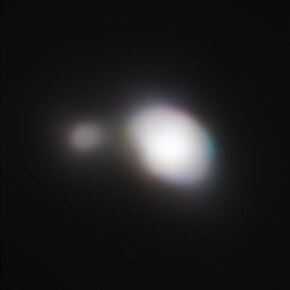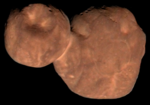66391 Moshup /ˈmɒʃʌp/, provisional designation 1999 KW4, is a binary asteroid, classified as a near-Earth object and potentially hazardous asteroid of the Aten group, approximately 1.3 kilometers in diameter. It was discovered on 20 May 1999, by Lincoln Near-Earth Asteroid Research (LINEAR) at the Lincoln Laboratory's Experimental Test Site in Socorro, New Mexico, United States. It is a Mercury-crosser that comes extremely close to the Sun at a perihelion of 0.2 AU.
Orbit
The asteroid orbits the Sun at a distance of 0.2–1.1 AU once every 6.18 months (188 days). Its orbit has an eccentricity of 0.69 and an inclination of 39° with respect to the ecliptic. A first precovery was taken by 2MASS at the Fred Lawrence Whipple Observatory in 1998, extending the body's observation arc by one year prior to its official discovery observation at Socorro.
As a potentially hazardous asteroid, it has an Earth minimum orbital intersection distance of 0.0138 AU (2,060,000 km), or 5.4 lunar distances. On 25 May 2036, it will pass 0.0155 AU (2,320,000 km) from Earth.
Numbering and naming
This minor planet was numbered by the Minor Planet Center on 10 September 2003. It was named from Mohegan legend, after Moshup, a giant who lived in the coastal areas of New England. The asteroid's companion is named Squannit, after the wife of Moshup and a medicine woman of the Makiawisug (little people). The official naming citation was published by the Minor Planet Center on 27 August 2019 (M.P.C. 115894).
Physical characteristics
In the SMASS classification, the asteroid a characterized as a stony S-type asteroid.
Satellite

Moshup has a minor-planet moon orbiting it. The moon, named Squannit /ˈskwɒnɪt/ and designated S/2001 (66391) 1, is approximately 360 metres in diameter, and orbits its primary every 16 hours at a mean distance of 2.6 kilometers. The presence of a companion was suggested by photometric observations made by Pravec and Šarounová and was confirmed by radar observations from Arecibo, announced on 23 May 2001 (also see below). Based on radar imaging, Squannit's dimensions are estimated to be 595 × 450 × 343 meters.
Diameter and shape


According to radiometric observations from Arecibo Observatory, the asteroid has an effective mean diameter of 1.317 kilometers. The observations were taken from May 21–23, 2001, by Lance A. M. Benner, Steven J. Ostro, Jon D. Giorgini, Raymond F. Jurgens, Jean-Luc Margot and Michael C. Nolan.
The Collaborative Asteroid Lightcurve Link adopts a diameter of 1.3 kilometers and derives an albedo 0.26 with an absolute magnitude of 16.5.
The shapes of the two bodies and their dynamics are complex. With a dimension of approximately 1.42 × 1.36 × 1.18 kilometers for a simple triaxial ellipsoid, the asteroid has an oblate shape, which is dominated by an equatorial ridge at the body's potential-energy minimum. This bizarre property of the equatorial region means that it is close to breakup: raising a particle a meter above the surface would put it into orbit. As seen in the image above, the gravitational effects between the moon and the asteroid create a gigantic mountain extending in the equatorial plane around the entire asteroid. It was the first asteroid to be described as "muffin-shaped", which is now understood to be a very common shape for asteroids in critical rotation, including 101955 Bennu and 162173 Ryugu.
Lightcurves
During 19–27 June 2000, a rotational lightcurve of this asteroid was obtained from photometric observations by Petr Pravec and Lenka Šarounová at Ondřejov Observatory. Lightcurve analysis gave a rotation period of 2.7650 hours with a brightness variation of 0.12 magnitude (U=3).
See also
References
- "ESO contributes to protecting Earth from dangerous asteroids". European Southern Observatory. 3 June 2019. Retrieved 3 June 2019.
- ^ "JPL Small-Body Database Browser: 66391 (1999 KW4)" (2017-05-31 last obs.). Jet Propulsion Laboratory. Retrieved 1 June 2017.
- ^ "66391 (1999 KW4)". Minor Planet Center. Retrieved 30 March 2017.
- ^ Ostro, Steven. J.; Margot, Jean-Luc; Benner, Lance A. M.; Giorgini, Jon D.; Scheeres, Daniel J.; Fahnestock, Eugene G.; et al. (November 2006). "Radar Imaging of Binary Near-Earth Asteroid (66391) 1999 KW4" (PDF). Science. 314 (5803): 1276–1280. Bibcode:2006Sci...314.1276O. doi:10.1126/science.1133622. PMID 17038586. S2CID 10927967. Retrieved 1 June 2017.
- ^ Pravec, P.; Scheirich, P.; Kusnirák, P.; Sarounová, L.; Mottola, S.; Hahn, G.; et al. (March 2006). "Photometric survey of binary near-Earth asteroids". Icarus. 181 (1): 63–93. Bibcode:2006Icar..181...63P. doi:10.1016/j.icarus.2005.10.014. Retrieved 1 June 2017.
- ^ "LCDB Data for (66391)". Asteroid Lightcurve Database (LCDB). Retrieved 1 June 2017.
- ^ Carbognani, Albino (October 2019). "The Color Indices of the NEA (66391) 1999 KW4". The Minor Planet Bulletin. 46 (4): 444. Bibcode:2019MPBu...46..444C. ISSN 1052-8091.
- "JPL Close-Approach Data: 66391 (1999 KW4)" (2013-05-09 last obs (arc=14.9 yr)). Retrieved 6 April 2016.
- "MPC/MPO/MPS Archive". Minor Planet Center. Retrieved 24 February 2018.
- Johnston, Robert (20 October 2019). "(66391) Moshup and Squannit". Johnston's Archive. Retrieved 30 March 2017.
- NASA Jet Propulsion Laboratory Asteroid Radar Research Archived 2007-12-07 at the Wayback Machine, retrieved May 3, 2007
- "Scientist: Asteroid To Return In 2036". www.cbsnews.com. 4 December 2006. Retrieved 2022-09-27.
- Jewitt, David; Weaver, Harold; Mutchler, Max; Li, Jing; Agarwal, Jessica; Larson, Stephen (2018). "The Nucleus of Active Asteroid 311P/(2013 P5) PANSTARRS". The Astronomical Journal. 155 (6): 231. arXiv:1804.05897. Bibcode:2018AJ....155..231J. doi:10.3847/1538-3881/aabdee. ISSN 1538-3881.
External links
- Margot, Jean-Luc, Radar observations of 1999 KW4 November 1999, retrieved July 2016
- Near-Earth Asteroid Is Two Chunks In One, NASA Jet Propulsion Laboratory, May 2001
- Asteroids with Satellites, Robert Johnston, johnstonsarchive.net
- 1999 KW4 orbit and observations at IAU Minor Planet Center
- 66391 Moshup at NeoDyS-2, Near Earth Objects—Dynamic Site
- 66391 Moshup at the JPL Small-Body Database
| Minor planets navigator | |
|---|---|
| Small Solar System bodies | |||||||
|---|---|---|---|---|---|---|---|
| Minor planets |
| ||||||
| Comets | |||||||
| Other | |||||||



